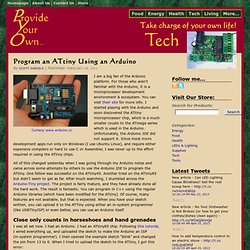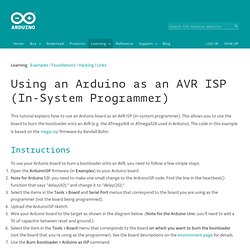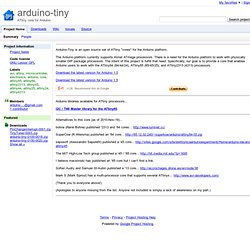

Program an ATtiny Using an Arduino. I am a big fan of the Arduino platform.

For those who aren’t familiar with the Arduino, it is a microprocessor development environment & ecosystem. You can visit their site for more info. I started playing with the Arduino and soon discovered the ATtiny microprocessor chip, which is a much smaller cousin to the ATmega series which is used in the Arduino. Unfortunately, the Arduino IDE did not support it. Since most micro development apps run only on Windows (I use Ubuntu Linux), and require either expensive compilers or hard to use C or Assembler, I was never up to the effort required in using the ATtiny chips. All of this changed yesterday when I was going through my Arduino notes and came across some attempts by others to use the Arduino IDE to program the ATtiny. Close only counts in horseshoes and hand grenades I was all set now. Avrdude: stk500_recv(): programmer is not responding I was close, but no cigar. Programming Your Own ATtiny – in 9 easy steps Troubleshooting Conclusion. Programming an ATtiny w/ Arduino.
This tutorial shows you how to program an ATtiny45 or ATtiny85 microcontroller using the Arduino software and hardware. The ATtiny45 and ATtiny85 are small (8-leg), cheap ($2-3) microcontrollers that are convenient for running simple programs. This tutorial is obsolete! See the updated version of this tutorial (with support for Arduino 1.0). They are almost identical, except that the ATtiny85 has twice the memory of the ATtiny45 and can therefore hold more complex programs.
We like to use both of them with paper circuits and other craft electronics. Materials and Tools For this tutorial, you’ll need: Arduino Uno or Duemilanove (w/ an ATmega328, not an older board with an ATmega168) ATtiny45 or ATtiny85 (8-pin DIP package) a 10 uF capacitor (e.g. from Sparkfun or from Digi-Key ) a breadboard jumper wires For more information, see our list of materials and parts and our list of prototyping supplies . Software Download: Arduino software , attiny45_85.zip. TWIMasterLibrary - arduino-tiny - I2C / TWI Master library for the ATtiny85. - ATtiny core for Arduino. ISP. Learning Examples | Foundations | Hacking | Links This tutorial explains how to use an Arduino board as an AVR ISP (in-system programmer).

This allows you to use the board to burn the bootloader onto an AVR (e.g. the ATmega168 or ATmega328 used in Arduino). The code in this example is based on the mega-isp firmware by Randall Bohn. Instructions To use your Arduino board to burn a bootloader onto an AVR, you need to follow a few simple steps. Open the ArduinoISP firmware (in Examples) to your Arduino board. Circuit (targeting Arduino Uno, Duemilanove, or Diecimila) An Arduino board serving as an ISP to program the ATmega on another Arduino board.
Circuit (targeting Arduino NG or older) On NG or older boards, connect the reset wire to pin 1 of the Atmega chip on the board, as shown above. Circuit (targeting an AVR on a breadboard) Arduino-tiny - ATtiny core for Arduino. Arduino-Tiny is an open source set of ATtiny "cores" for the Arduino platform.

The Arduino platform currently supports Atmel ATmega processors. There is a need for the Arduino platform to work with physically smaller DIP package processors. The intent of this project is fulfill that need. Specifically, our goal is to provide a core that enables Arduino users to work with the ATtiny84 (84/44/24), ATtiny85 (85/45/25), and ATtiny2313 (4313) processors.
Download the latest version for Arduino 1.0 Download the latest version for Arduino 1.5 Arduino libraries available for ATtiny processors... I2C / TWI Master library for the ATtiny85 Alternatives to this core (as of 2010-Nov-16)... bohne (René Bohne) published '2313 and '84 cores... SuperCow (R.Wiersma) published an '84 core... saposoft (Alessandro Saporetti) published a '45 core... The MIT High-Low Tech group published a '45 / '85 core... I believe macsimski has published an '85 core but I can't find a link. (Thank you to everyone above!)